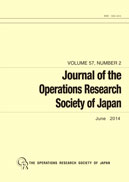Volume 38, Issue 1
Displaying 1-14 of 14 articles from this issue
- |<
- <
- 1
- >
- >|
-
Article type: Cover
1995Volume 38Issue 1 Pages Cover1-
Published: 1995
Released on J-STAGE: June 27, 2017
Download PDF (124K) -
Article type: Appendix
1995Volume 38Issue 1 Pages App1-
Published: 1995
Released on J-STAGE: June 27, 2017
Download PDF (134K) -
Article type: Article
1995Volume 38Issue 1 Pages 1-20
Published: 1995
Released on J-STAGE: June 27, 2017
Download PDF (1703K) -
Article type: Article
1995Volume 38Issue 1 Pages 21-33
Published: 1995
Released on J-STAGE: June 27, 2017
Download PDF (671K) -
Article type: Article
1995Volume 38Issue 1 Pages 34-54
Published: 1995
Released on J-STAGE: June 27, 2017
Download PDF (1683K) -
Article type: Article
1995Volume 38Issue 1 Pages 55-69
Published: 1995
Released on J-STAGE: June 27, 2017
Download PDF (901K) -
Article type: Article
1995Volume 38Issue 1 Pages 70-88
Published: 1995
Released on J-STAGE: June 27, 2017
Download PDF (1169K) -
Article type: Article
1995Volume 38Issue 1 Pages 89-106
Published: 1995
Released on J-STAGE: June 27, 2017
Download PDF (1148K) -
Article type: Article
1995Volume 38Issue 1 Pages 107-123
Published: 1995
Released on J-STAGE: June 27, 2017
Download PDF (1163K) -
Article type: Article
1995Volume 38Issue 1 Pages 124-136
Published: 1995
Released on J-STAGE: June 27, 2017
Download PDF (1002K) -
Article type: Appendix
1995Volume 38Issue 1 Pages 137-139
Published: 1995
Released on J-STAGE: June 27, 2017
Download PDF (173K) -
Article type: Appendix
1995Volume 38Issue 1 Pages App2-
Published: 1995
Released on J-STAGE: June 27, 2017
Download PDF (162K) -
Article type: Cover
1995Volume 38Issue 1 Pages Cover2-
Published: 1995
Released on J-STAGE: June 27, 2017
Download PDF (95K) -
Article type: Cover
1995Volume 38Issue 1 Pages Cover3-
Published: 1995
Released on J-STAGE: June 27, 2017
Download PDF (95K)
- |<
- <
- 1
- >
- >|
